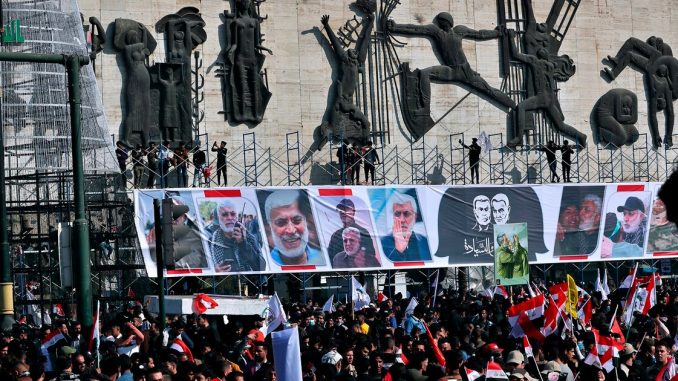
BAGHDAD — Chanting anti-American slogans, thousands of Iraqis converged on a landmark square in central Baghdad on Sunday to commemorate the anniversary of the killing of a powerful Iranian general and a top Iraqi militia leader in a U.S. drone strike.
Roads leading to Tahrir Square were closed off and security was tight as the crowds gathered in response to a call by powerful Iran-backed militias for a rally marking the occasion and demanding the expulsion of U.S. troops from Iraq.
“No, no to America!” shouted some in the largely mask-less crowd. “You killed our guest. There is no place here for your embassy,” read some of the banners.
Protesters at one point set fire to a large U.S. flag, drawing cheers from the crowd.
The killing of Gen. Qassim Soleimani and Abu Mahdi al-Muhandis at Baghdad’s airport pushed Tehran and Washington perilously close to all-out conflict and sparked outrage in Iraq, leading parliament to pass a non-binding resolution days later calling for the expulsion of all foreign troops from Iraq.
/cloudfront-us-east-1.images.arcpublishing.com/mco/J55SU3MXRRDWRLX46WTNY5XKZ4.jpg)
Sunday’s rally was being held amid heightened tensions between Iran and the U.S. in the final days of President Donald Trump’s administration.
Already, America has conducted B-52 bomber flyovers and sent a nuclear submarine into the Persian Gulf over what Trump officials describe as the possibility of an Iranian attack on the anniversary of the strike that killed Soleimani and al-Muhandis.
Carrying Iraqi and militia flags and posters of the two men, thousands of Iraqis marched toward Tahrir Square for the rally Sunday, demanding the withdrawal of U.S. troops in implementation of the parliamentary resolution. The event was organized by mostly Iran-backed militias known as the Popular Mobilization Forces.
“We call upon the government and the parliament to expel the occupying foreign forces, especially the brutal American forces, the infidels, the immorals, who killed the heroes and leaders of victory,” said Muhammad Shubr al-Husseini, a protester.
Abbas Ali, a 27-year-old protester carrying a poster of Soleimani, said he was there because it was a day “to remember those who sacrificed their souls for Iraq.”
/cloudfront-us-east-1.images.arcpublishing.com/mco/SDR4R3YPHVE7NICQS7RXO4DNLA.jpg)
Soleimani headed the elite Quds Force of Iran’s Revolutionary Guard, responsible for the Islamic Republic’s foreign operations, and he frequently shuttled between Iraq, Lebanon and Syria. Al-Muhandis was Iraq’s most powerful militia leader and was deputy commander of the PMF.
They both gained prominence for advising Shiite paramilitary forces fighting the Islamic State group in Iraq, before it was defeated in 2017.
Their killing dramatically ratcheted up tensions in the region and brought the U.S. and Iran to the brink of war. Iran hit back by firing a barrage of ballistic missiles at two Iraqi bases housing U.S. troops, some of whom suffered concussions. Iranian officials have suggested that more retaliation is coming.
/arc-anglerfish-arc2-prod-mco.s3.amazonaws.com/public/622GZ7LTKBGBPL4GHNCRKR3IAU.jpg)
What war with Iran could look like
Military Times interviewed more than a dozen military experts, including current and former U.S. military officials, about how a conflict might begin and how it could play out. This is what they said could happen:
On Saturday night, thousands of people took part in a commemoration ceremony held at Baghdad’s airport where the strike took place a year ago.
Mourners, many of them members of the PMF, joined a march on the highway leading to the airport. Posters of the dead men adorned both sides of the road, which was lined with tents that served food and drinks for those who walked the highway.
The scene of the bombing was turned into a shrine-like area sealed off by red ropes, with a photo of Soleimani and al-Muhandis in the middle, as mourners lit candles. Shrapnel marks were still visible on the asphalt and concrete blast walls in the area.
The wreckage of two cars was on display on the road outside the airport as a reminder of the attack.
In Lebanon, the Shiite militant Hezbollah grouped marked the anniversary of Soleimani’s killing with a symbolic event on a hill in the country’s south overlooking the border area with Israel.
A group of Hezbollah fighters dressed in military uniforms swore the oath of Hezbollah while officials raised the group’s yellow flag with posters of Soleimani and al-Muhandis on it.
Hezbollah leader Hassan Nasrallah was expected to deliver a speech later Sunday.
Karam reported from Beirut.



Be the first to comment